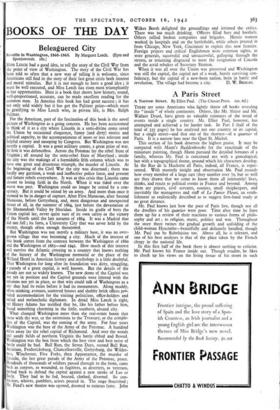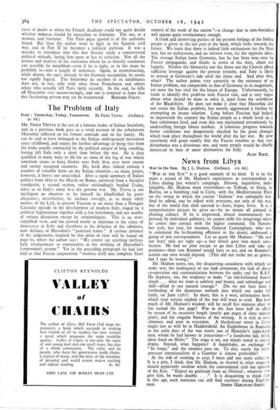A Paris Street
A Narrow Street. By Elliot Paul. (The Cresset Press. los. 6d.)
THERE are some Americans who, lightly throw off books revealing the "inside" of whole continents. Others, like Mr. Shirer and Mr. Wallace Deuei, have given us valuable estimates of the trend of events inside a single country. Mr. Elliot Paul, however, has attempted and achieved a far harder task. In Part I (half of the total of 335 pages) he has analysed not one country or its capital, but a single street—and that one of the shortest—of a quartier of Paris. It is a narrow lane near the Quai St. Michel.
This section of his book deserves the highest praise. It may be compared with Mann's Budden brooks for the exactitude of the miniature painting, though Mann pursued the detailed fortunes of a family, whereas Mr. Paul is concerned not with a genealogical, but with a topographical theme, around which his characters develop. In the Rue de la Huchette all Paris, indeed, all France, is repre- sented._ With masterly insight and observation Mr. Paul records how every member of a large cast (they number over 70, but so well are they drawn that we come to know them all intimately) lives, thinks, and reacts to political events in France and beyond. Among them are priests, civil servants, rentiers, small shopkeepers, and inevitably the manageress and staff of Le Panier Fleuri, an estab- lishment so realistically described as to suggest first-hand study at no great distance.
Mr. Paul knows just how the poor of Paris live, though not all the dwellers of his guarder were poor. Time after time he lines them up for a review of their reactions to various forms of philo- sophy and art ; to religion, music, politics and war. Throughout the story there twines the gradual growth and unfolding of the child-woman Hyacinthe—beautifully and delicately handled, though Mr. Paul can be Rabelaisian too. Above all, he is tolerant, and one of his best analyses is that of the place taken by the French dergy in the national life.
In this first half of the book there is almost nothing to criticise. Mr. Paul knows his France inside out. Though erudite, he likes to check up his views on the living tissue of his street in such
cases of doubt as when the French Academy could not quite decide whether mimosa should be masculine or feminine. The rue, to .a woman, said feminine. The Paris argot quoted is of the authentic brand. But then the author went to fight in the Spanish civil war, and in Part II he becomes a political partisan. It was a mistake to introduce into this fine literary study a controversial political attitude, laying him open at last to criticism. Not all the actions and motives of the statesmen whom he so bitterly condemns can possibly be simplified—even if he is right, as in the main he probably is—into a couple of sentences. Again, in reconstructing, while absent, the rue's attitude to the German occupation, he seems too rigidly logical. The behaviour he ascribes to its inhabitants does not, in fact, tally with what those Frenchmen and others relate who actually left Paris fairly recently. In the end, he kills off Hyacinthe very unconvincingly, and one is tempted to hope that
this fascinating person may yet be resurrected. BERNARD FOLEY.



























 Previous page
Previous page